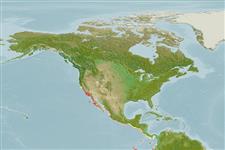Gastropoda |
Trochida |
Turbinidae
Environment: milieu / climate zone / εύρος βάθους / distribution range
Οικολογία
; εύρος βάθους 1 - 100 m (Αναφ. 121891). Subtropical; 34°N - 24°N, 120°W - 111°W
Eastern Pacific: from Point Conception, California, USA to Bahia Magdalena, Mexico.
Length at first maturity / Μέγεθος / Weight / Age
Γεννητική Ωρίμανση: Lm ? range ? - ? cm Max length : 15.0 cm SHD αρσενικό/απροσδιόριστο; (Αναφ. 121668)
Coastal (Ref. 121668). It is found on rocks, usually in kelp beds, from low intertidal to a depth of 21 meters (Ref. 865). Also in subtidal habitats (Refs. 121666, 121667) and rocky reefs (Ref. 121668). Herbivorous (Refs. 121666, 121667), primarily feeds on the giant kelp Macrocystis pyrifera; also consumes a variety of fleshy and calcareous macroalgae (Ref. 121667).
Life cycle and mating behavior
Γεννητική Ωρίμανση | Αναπαραγωγή | Γεννοβολία | Eggs | Γονιμότητα | Larvae
Members of the order Patellogastropoda are mostly gonochoric and broadcast spawners. Life cycle: Embryos develop into planktonic trocophore larvae and later into juvenile veligers before becoming fully grown adults.
Bisby, F.A., M.A. Ruggiero, K.L. Wilson, M. Cachuela-Palacio, S.W. Kimani, Y.R. Roskov, A. Soulier-Perkins and J. van Hertum 2005 Species 2000 & ITIS Catalogue of Life: 2005 Annual Checklist. CD-ROM; Species 2000: Reading, U.K. (Αναφ. 19)
IUCN Red List Status
(Αναφ. 130435: Version 2025-1)
CITES status (Αναφ. 108899)
Not Evaluated
Not Evaluated
Threat to humans
Human uses
αλιεία: Εμπορικό(ά)
| FishSource |
Εργαλεία
Περισσότερες πληροφορίες
Life cycleΑναπαραγωγήΓεννητική ΩρίμανσηΓονιμότηταΓεννοβολίαEggsEgg developmentLarvae PhysiologyΚατανάλωση οξυγόνου
Human RelatedStamps, coins, misc.
Διαδικτυακές πηγές
Estimates based on models
Preferred temperature
(Ref.
115969): 15.9 - 24.4, mean 18.6 (based on 60 cells).
Ελαστικότητα
Μεσαίο(α), ελάχιστος χρόνος για διπλασιασμό πληθυσμού 1,4 - 4,4 έτη (K=0.24).
Fishing Vulnerability
Low to moderate vulnerability (34 of 100).
Price category
Unknown.
